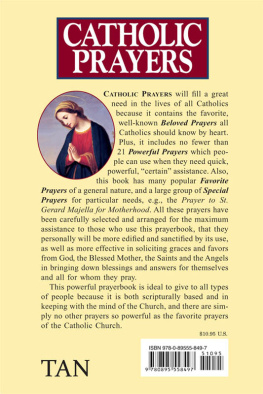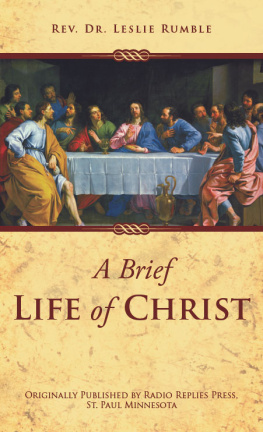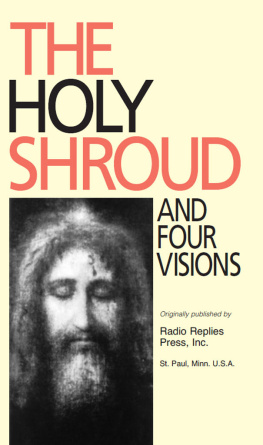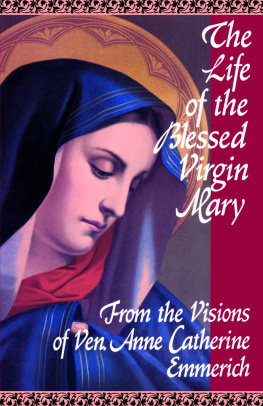Very Rev. K. E. Schmoger - The Life and Revelations of Anne Catherine Emmerich Volume 2
Here you can read online Very Rev. K. E. Schmoger - The Life and Revelations of Anne Catherine Emmerich Volume 2 full text of the book (entire story) in english for free. Download pdf and epub, get meaning, cover and reviews about this ebook. year: 2013, publisher: TAN Books, genre: Religion. Description of the work, (preface) as well as reviews are available. Best literature library LitArk.com created for fans of good reading and offers a wide selection of genres:
Romance novel
Science fiction
Adventure
Detective
Science
History
Home and family
Prose
Art
Politics
Computer
Non-fiction
Religion
Business
Children
Humor
Choose a favorite category and find really read worthwhile books. Enjoy immersion in the world of imagination, feel the emotions of the characters or learn something new for yourself, make an fascinating discovery.

- Book:The Life and Revelations of Anne Catherine Emmerich Volume 2
- Author:
- Publisher:TAN Books
- Genre:
- Year:2013
- Rating:4 / 5
- Favourites:Add to favourites
- Your mark:
- 80
- 1
- 2
- 3
- 4
- 5
The Life and Revelations of Anne Catherine Emmerich Volume 2: summary, description and annotation
We offer to read an annotation, description, summary or preface (depends on what the author of the book "The Life and Revelations of Anne Catherine Emmerich Volume 2" wrote himself). If you haven't found the necessary information about the book — write in the comments, we will try to find it.
The Life and Revelations of Anne Catherine Emmerich Volume 2 — read online for free the complete book (whole text) full work
Below is the text of the book, divided by pages. System saving the place of the last page read, allows you to conveniently read the book "The Life and Revelations of Anne Catherine Emmerich Volume 2" online for free, without having to search again every time where you left off. Put a bookmark, and you can go to the page where you finished reading at any time.
Font size:
Interval:
Bookmark:


A PPROBATION
As the second volume of the work entitled Life and Revelations of Anne Catherine Emmerich, by Father Schmger, C.SS.R., like the first, contains nothing contrary to the teachings of the Catholic Church, either in morals or dogma; but which, if read in the spirit of piety, may contribute much to the edification of the faithful, we willingly give it after a careful perusal the approbation solicited by the author.
 PETER JOSEPH,
PETER JOSEPH,
Bishop of Limbourg
Reprinted from the 1968 edition of Maria Regina Guild, Los Angeles, California, itself reprinted from the English edition of 1885.
| ISBN: Volume 1978-0-89555-059-0 |
| Volume 2978-0-89555-060-6 |
| The Set978-0-89555-061-3 |
Printed and bound in the United States of America.
TAN Books
An Imprint of Saint Benedict Press, LLC
Charlotte, North Carolina
2012
D EDICATION
To the Immaculate Heart of the Virgin Mary, Mother of God, Queen of Heaven and Earth, Lady of the Most Holy Rosary, Help of Christians, and Refuge of the Human Race .
C ONTENTS
A UTHOR S P REFACE
W E advance as a proof of the respect and affection in which the venerable Anne Catherine Emmerich is held by the faithful, the fact that, a short time after the appearance of the first volume of the present biography, it was translated into French from 1858 until her blessed death, alone sustained him in his undertaking and enabled him to bring it to a happy conclusion.
Sister Emmerich had herself denominated the Pilgrims notes, A pathless, overgrown garden. In March, 1820, she related the following vision, remarkable on account of its and which seems to be the center to which all her labors tended.
The Pilgrim appears never to have clearly comprehended this vision; but, fortunately, he preserved so many of the Sisters communications on the subject as to enable the author to penetrate more deeply into its signification. Then only did he seize the order and import of this privileged souls immense task of prayer for the Church as a body, as well as for her individual members; then only did he feel that he might attempt the history of her life.
The first volume has been drawn mostly from Dr. Weseners notes, as also the Pilgrims, of whatever they could glean from the invalid herself, from her confessor, her companions, her relatives, respecting her past life. The Pilgrim during his five years sojourn in Dlmen kept up a large correspondence with his dearest and most confidential friends. These unpublished letters were placed at the authors service, and he has made use of them with the greatest discretion. He looks upon them as one of the greatest proofs of the blessed influence exercised by Sister Emmerich over her amanuensis. Only two of those that were honored by Sister Emmerichs special affection and confidence are yet living (1870): Misses Apollonia Diepen-brock and Louise Hensel, both of whom kindly aided the author with their communications.
In 1831, the Pilgrim had revised the record of only the first months of his stay at Dlmen; of this, however, the author has not availed himself, as it does not faithfully accord with the original notes. To avoid copying, the Pilgrim corrected his journal after having recorded some visions; but he seems to have grown discontented with the task, and abandoned any further attempts of the kind. His interspersing the above with all sorts of notes and remarks, many of them quite irrelevant, contributed to the greater confusion of the whole. If, for instance, Sister Emmerich were prevented from communicating her visions, complaints filled his journal against her confessor or anyone else who had been, according to him, the cause of these intolerable interruptions. These complaints he repeated in his private letters and, as they were published after his death, the author feels that a word of explanation on the subject is necessary. They to whom his letters were addressed were fully aware of his irritable temperament and also of the circumstances attendant on his penning them; consequently, they bore not for them that tone of asperity with which they could not fail to impress the general reader. The author, therefore, feels it a duty to expose clearly, justly, and conscientiously, the true state of affairs, that a correct and unbiased opinion may be formed of Sister Emmerichs position and her surroundings so frequently subjected to the Pilgrims harsh criticism. The author himself was tempted, at first, to sympathize with the Pilgrim, and it was only after a long and close examination that he was able to discover the truth. In this he feels convinced that he conforms to the Pilgrims own intentions, since ten years before his death he had nourished the thought of entrusting the arrangement of his notes to someone in whose discretion he might perfectly confide; he thought of handing over to such a person his manuscripts just as they were, without retrenching a single line, and of allowing him to estimate their contents conscientiously and impartially. As time glided on and the Pilgrim himself began to cast a cooler, more impartial glance upon the years spent in Dlmen, the more averse did he become to encountering anew the thorns that human frailty had led him to plant around the roses in his garden. He would then have erased from his journal his captious remarks, had he not feared that by so doing he might suppress what was both important and necessary to the clear understanding of Sister Emmerichs position. With rare uprightness and moral courage, he preserved what he had written that even the dispraise thereby accruing to himself might render its own peculiar testimony to the chosen of God.
In conclusion, the author submits unreservedly to the decrees of Urban VIII, and declares that he attributes only purely human belief to the extraordinary facts and incidents recorded in the present volume.
P. SCHMGER, C.SS.R.
C ONVENT OF G ARS , B AVARIA ,
Feast of St. John Baptist , 1870
Chapter 1
S PIRITUAL L ABORS AND S UFFERINGS FOR THE C HURCH . T HE N UPTIAL H OUSE . A CTION IN V ISION .
I N November, 1820, Sister Emmerich remarked: It is now twenty years since my Spouse led me into the Nuptial House and laid me upon the hard bridal bed on which I still lie; thus did she designate her labors for the Church, labors imposed upon her from her entrance into Agnetenberg. No account had ever been demanded of this hidden operation, no director had even been willing to listen to her on the subject, and it is only now, toward the close of her career, that she testifies to the ways by which God had led her for the good of the Church; now, for the first time, does she raise the veil which conceals that mysterious action which, though operated in contemplation, derives its origin and merit, its importance and results from the divine virtue of faith. Before her entrance into religion, her principal task consisted in expiatory sufferings referring to the religious vocation and vows; but, when she had embraced the conventual life, her action was extended to the whole Church. What this task embodied she characterized by these striking words: My Heavenly Bridegroom brought me into the Nuptial House, for such is the relation that the Church holds with Jesus Christ, her Spouse and Heada relation which was shown to Sister Emmerich as an immense sphere, embracing the most varied and opposite states, for whose individual failings she was to supply by her sufferings. Jesus is continually renewing His indissoluble union with the Church, His Spouse, and that He may present her spotless to His Father, He incessantly pours out upon her the torrents of His graces. But every grace must be accounted for, and few among those who receive them would be found ready for this, if the Heavenly Spouse did not at all times prepare chosen souls to gather up what others waste, to utilize the talents that others bury, and to discharge the debts contracted by the negligent. Before manifesting Himself in the flesh, in order to ratify the New Alliance with His Blood, He had by the Immaculate Conception of Mary prepared her to be the immaculate type of the Church. He had poured upon her the plenitude of His graces, that her prayers might hasten the Messiahs advent, her purity and fidelity retain Him among the very men who received Him not, who resisted and persecuted Him. When Jesus, the Good Shepherd, began to gather His flock together it was Mary who cared for them, particularly for the poorest, the most abandoned, in order to lead them into the way of salvation; she was the faithful stewardess, she was the support of all. After the return of her Son to His Eternal Father, she remained many years upon earth to strengthen and protect the infant Church. And until the second coming of her Son, the Church will never be without members who, following in her footsteps, will be so many sources of benediction to their brethren. It is Mary, the Mother of Mercy, who assigns to these privileged souls their tasks for the ecclesiastical year; and, in accordance with this order, Sister Emmerich received, in what she denominates the Nuptial House , her yearly portion of expiation for the Church. Every detail was made known to her, all was to be finished in a certain time, for choice and duration of suffering are at the option of none. This order was indicated by the different parts of the Nuptial House, which had both a symbolical and historical signification. It was the house of Jesse near Bethlehem, the house in which David was born, in which he had been trained by God Himself for his future career as a prophet. It was from this house, also, that the Divine Spouse Himself had sprung in His Holy Humanity. It was the house of the royal race of the Immaculate Virgin, Mother of the Church, and the paternal house of St. Joseph. It was fitting that Sister Emmerich should contemplate therein the present state of the Church and receive her mission for it, since its former holy occupants had hailed in spirit the advent of the Redeemer, had gazed upon the Churchs career through coming ages, and had received their share in the good works that were to hasten Redemption.
Next pageFont size:
Interval:
Bookmark:
Similar books «The Life and Revelations of Anne Catherine Emmerich Volume 2»
Look at similar books to The Life and Revelations of Anne Catherine Emmerich Volume 2. We have selected literature similar in name and meaning in the hope of providing readers with more options to find new, interesting, not yet read works.
Discussion, reviews of the book The Life and Revelations of Anne Catherine Emmerich Volume 2 and just readers' own opinions. Leave your comments, write what you think about the work, its meaning or the main characters. Specify what exactly you liked and what you didn't like, and why you think so.






